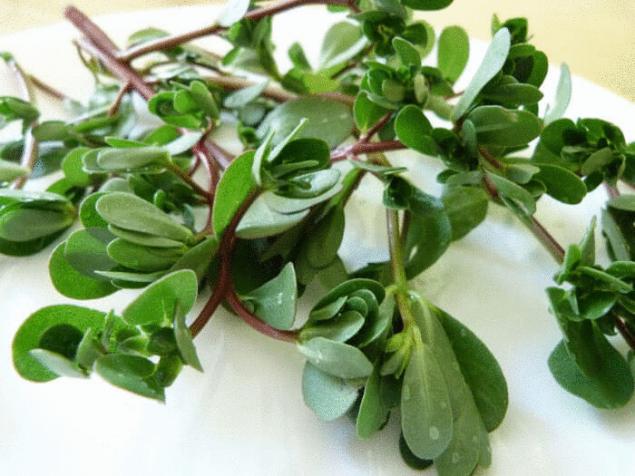The purslane: a unique nutritional and medicinal properties
 Bashny.Net
Bashny.Net
The purslane — an annual herbaceous succulent plant. The stem is procumbent, smooth, reddish, 10-30 cm (40 cm), branched from the base.
Leaves sessile, fleshy, cuneate-obovate, oblong-cuneate, rotary, blunt; lower leaves are arranged spirally, the upper — opposite.

The flowers are small, yellow, sessile, in clusters of two or three in the branching of the stem or in the leaf axils.
The fruit is ovoid or spherical capsule, dehiscing with transverse crack. This kind of box is called krynicki. Blooms in June—August. The fruits ripen in September.
Chemical composition
The aerial part of Portulaca contains:
proteins, sugars, trace elements (zinc, copper, manganese, Nickel, iron), microelements (calcium, magnesium, sodium, potassium), organic acids, alkaloids, saponins and other glycosides, norepinephrine, a significant amount of vitamins — carotene, tocopherol, ascorbic acid (0.3 %), nicotinic acid, and phylloquinone, mucous and resinous substances; seeds — a fatty oil, which includes linoleic, oleic, palmitic and other fatty acids.

In cooking
Young leaves and stems are used in food raw and cooked. From them prepare spicy salads, soups, purees and seasonings. In winter, salted and marinated using as a substitute for capers. The most popular herbs of the purslane uses since the population of the Caucasus, Central Asia, in the Mediterranean countries.
Many say that purslane is a food of the future. The purslane is very rich in iron, calcium and other minerals.
In medicine
As a medicinal plant purslane, known since Hippocrates. In ancient times believed that its seeds "cleanse the body". The leaves of purslane was used in medicine of the past as wound healing, diuretic; the mixture for the treatment of impotence, as an anti-toxic remedy for the bites of poisonous snakes and insects, Trichomonas vaginitis, insomnia, flatulence, diseases of the liver and kidneys, in scurvy and other vitamin deficiency, dysentery; seeds in the treatment of psoriasis.
Purslane lowers blood sugar and may be recommended in the diet of patients with mild diabetes.
Crushed aerial part of the plant is applied to the ground bee stings, reduces swelling and inflammation.published
P. S. And remember, only by changing their consumption — together we change the world! ©
Source: veganeducation.blogspot.com/2014/08/blog-post_27.html
Leaves sessile, fleshy, cuneate-obovate, oblong-cuneate, rotary, blunt; lower leaves are arranged spirally, the upper — opposite.

The flowers are small, yellow, sessile, in clusters of two or three in the branching of the stem or in the leaf axils.
The fruit is ovoid or spherical capsule, dehiscing with transverse crack. This kind of box is called krynicki. Blooms in June—August. The fruits ripen in September.
Chemical composition
The aerial part of Portulaca contains:
proteins, sugars, trace elements (zinc, copper, manganese, Nickel, iron), microelements (calcium, magnesium, sodium, potassium), organic acids, alkaloids, saponins and other glycosides, norepinephrine, a significant amount of vitamins — carotene, tocopherol, ascorbic acid (0.3 %), nicotinic acid, and phylloquinone, mucous and resinous substances; seeds — a fatty oil, which includes linoleic, oleic, palmitic and other fatty acids.

In cooking
Young leaves and stems are used in food raw and cooked. From them prepare spicy salads, soups, purees and seasonings. In winter, salted and marinated using as a substitute for capers. The most popular herbs of the purslane uses since the population of the Caucasus, Central Asia, in the Mediterranean countries.
Many say that purslane is a food of the future. The purslane is very rich in iron, calcium and other minerals.
In medicine
As a medicinal plant purslane, known since Hippocrates. In ancient times believed that its seeds "cleanse the body". The leaves of purslane was used in medicine of the past as wound healing, diuretic; the mixture for the treatment of impotence, as an anti-toxic remedy for the bites of poisonous snakes and insects, Trichomonas vaginitis, insomnia, flatulence, diseases of the liver and kidneys, in scurvy and other vitamin deficiency, dysentery; seeds in the treatment of psoriasis.
Purslane lowers blood sugar and may be recommended in the diet of patients with mild diabetes.
Crushed aerial part of the plant is applied to the ground bee stings, reduces swelling and inflammation.published
P. S. And remember, only by changing their consumption — together we change the world! ©
Source: veganeducation.blogspot.com/2014/08/blog-post_27.html
Tags
See also
It's hard to believe! The unique healing properties of quinoa
The unique properties of balm "Asterisk", which did not even our parents
The unique healing properties of Tibetan milk mushroom
Propolis: the unique healing properties
The amazing healing properties of black pepper
Incredible medicinal plant for longevity - amaranth
An invaluable benefit of nutmeg
Every natural product has certain medicinal properties.
The healing properties of dried fruits
Artichoke - a plant with unique healing properties

















